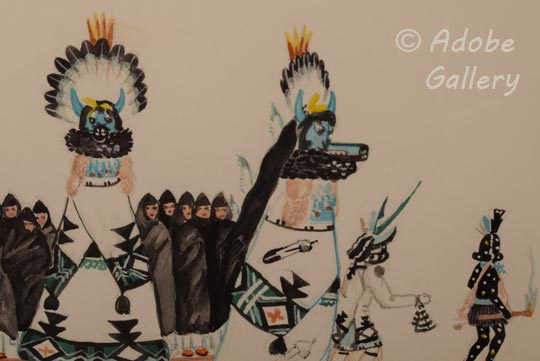Watercolor of Zuni Shalako Ceremony [SOLD]
+ Add to my watchlist Forward to Friend
- Category: Paintings
- Origin: Zuni Pueblo, SHE-WE-NA
- Medium: watercolor
- Size:
11" x 8-½” image;
16-½” x 14” framed - Item # C4803K SOLD
The Zuni Shalako Ceremony, which is the most important event of the year at Zuni Pueblo, takes place in early winter and is open to the public. It goes on all night, and when the Shalakos leave the ceremony, it is said that they go to the gods to ask for rain in the coming year. The Shalakos are considered messengers to the gods, transporting messages throughout the year, in addition to bringing rain and favorable weather conditions.
This is a painting by the highly acclaimed Zuni Pueblo painter, Kai-Sa, which depicts this special, significant ceremony in a way that only a member of Zuni Pueblo could accomplish. The painting, which was made in the traditional Native American flat style, is rich in detail and meaning.
There are two Shalakos featured in this piece, one seen from a side facing view and the other from the front. Each is dressed in customary Shalako regalia, consisting of a long white manta decorated with many sacred adornments. Some of these include rain clouds, feathers, kiva steps, corn symbols, and more.
Also included in the painting are the Shulawitsi katsina (the Little Pekwin or Little Fire God), Saiyatasha katsina (the Rain Priest of the North, or Long Horn), and Salimopia Kohan'ona katsina (the Red Warrior of the South). Behind all of the main figures there is a very large group of people dressed in long black gowns. We believe these are the "cluster of men singing antiphonally" referenced on page 37 of "Kachinas of the Zuni" by Barton Wright. This piece is an excellent portrayal not only of the Shalako ceremony, but also of the excitement and mystery that hovers in the air during this sacred time at Zuni Pueblo.
 The painting is signed in the bottom left, Kai-sa.
The painting is signed in the bottom left, Kai-sa.
Zuni Pueblo artist Percy Sandy was known for his paintings which depicted traditional ceremonies and life in the pueblo villages. His style could be seen as loose and natural certainly because of his experience as an artist. He often chose bright colors, and balanced them by using a wispy, nearly translucent application.
Percy Tsisete Sandy (1918-1974) Kai-Sa - Red Moon was also influenced by other Native American artists such as Taos Pueblo artist Pop Chalee. He has used Hopi and Rio Grande Puebloan styles as well as Navajo (Diné) and even Apache.
Percy Sandy attended elementary and secondary schools of the village of Zuni, then went on to Santa Fe to take a year's postgraduate work in art at the Indian School. Kai-Sa was surely influenced while at the Indian School in Santa Fe, whether by other Native American student artists he encountered there or by their paintings he saw there.
Kai-Sa was born at Zuni Pueblo in 1918. He later moved from Zuni to Taos Pueblo, due to internal conflicts connected to his depiction of sensitive religious subjects. He died in Taos in 1974.
Condition: very good condition
Provenance: this Watercolor of Zuni Shalako Ceremony is from a client of Adobe Gallery
Recommended Reading: Southwest Indian Painting: a changing art by Clara Lee Tanner, Kachinas of the Zuni by Barton Wright
TAGS: Zuni Pueblo, Taos, Diné of the Navajo Nation, Native American Paintings, Pop Chalee Hopi Pueblo, Apache, Percy Sandy

- Category: Paintings
- Origin: Zuni Pueblo, SHE-WE-NA
- Medium: watercolor
- Size:
11" x 8-½” image;
16-½” x 14” framed - Item # C4803K SOLD
Adobe Gallery Recommended Reading
Adobe Gallery Recommended Items
If you are interested in this item, we would also like to recommend these other related items:



